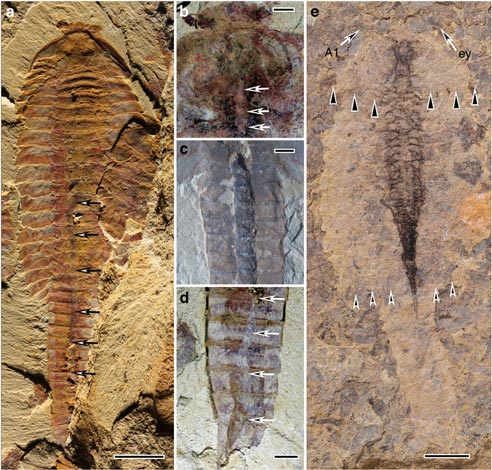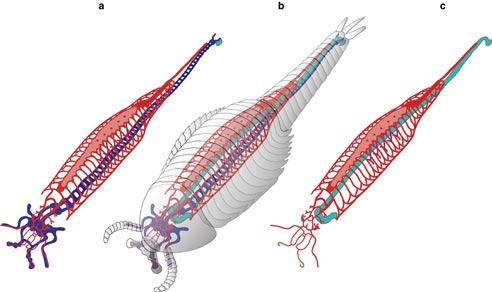Earliest Cardiovascular System Described from Chinese Cambrian Arthropod
Oldest Known Cardiovascular System Identified – Fuxianhuia protensa
The fossil of an arthropod found in rocks laid down around 520 million years ago with an exquisitely preserved cardiovascular system has been described by a team of scientists led by researchers from the Natural History Museum in London. The specimen represents the oldest known fossil showing a rudimentary heart and blood vessels known to science.
Burgess Shale and Other Remarkable Fossil Sites
Thanks to remarkable fossil sites such as the Burgess Shale deposits in British Columbia and beautifully preserved remains of Cambrian creatures from highly fossiliferous strata from south-western China, palaeontologists have built up an astonishing amount of data on life in the seas and oceans of the world around 520 to 500 million years ago, a period in the geological history of planet Earth known as the Cambrian explosion due to the range and diversity of organisms that had evolved at that time.
The exquisitely preserved specimen represents Fuxianhuia protensa from the Middle Cambrian aged strata of the Chengjiang Formation (the Moatianshan shales of Yunnan Province, south-west China). Fossils of this shrimp-like creature are very common in these marine shales, sixteen different phyla that have been identified from the Chengjiang Formation, a location that rivals the Burgess Shales in terms of the rich fossil record that has been preserved, although the material from the Chengjiang Formation is slightly older than the fossils from the Walcott Quarry section of the Burgess Shale deposits. Until this particular specimen had been studied, it has been assumed that most of the internal organs of early arthropods would not survive the fossilisation process.
Fuxianhuia protensa
Some fossils had been found that indicated the presence of a digestive tract and back in October 2013, Everything Dinosaur reported the discovery of an arthropod (Alalcomenaeus spp.) from the same region of Yunnan Province that showed signs of a brain and the soft tissue preservation of a nervous system, here we report on the discovery and mapping of a complete cardiovascular system in a 520-million-year-old arthropod.
To read more about this earlier discovery: Ancient Arthropod Brain and Nervous System Studied.
Although many fossils of F. protensa are known, its taxonomic position with the Arthropoda remains unclear, it is thought to be a basal member of this phylum, which today is the largest phylum of animals and includes crustaceans, insects, spiders, mites, scorpions, centipedes, king crabs millipedes and a number of extinct Orders such as the Trilobita.
The external skeleton is most commonly preserved, either as parts shed as the animal grew or as complete specimens that represent animals that died, however, due to the exquisite degree of preservation in some specimens from the Chengjiang Formation, scientists now have a much better understanding of the internal anatomy of early arthropods. What is remarkable, is that sophisticated cardiovascular and nervous systems seem to have evolved in the Arthropoda at an early stage in the history of life on Earth.
Fuxianhuia Fossils that have been used in the Study
Picture credit: Journal of Nature Communications
Fossil Examples
The photograph shows examples of the F. protensa fossil material used in the study. Diagram (a) is a view of specimen YKLP 11336 from above (dorsal view), the location of the digestive tract running down the centre of the body is indicated by the black arrows.
Illustration (b) shows the head and the front of the animal (anterior view), specimen number YKLP 11337, the white arrows indicate the mouth of the creature. Part (c) shows the filled gut within the abdominal segments, the gut has been preserved as carbon in this specimen (YKLP 11338). Diagram (d) shows empty gut area marked by arrows in abdominal segments Ab9 to Ab14.
Diagram (e) shows the preserved outline of the cardiovascular system (YKLP 11335), A1 in the photograph marks the position of the left antenna and ey marks the position of the right eye. The black triangles towards the top of the picture indicate the position of the bottom portion of the animal’s headshield. The white outlined triangles towards the bottom of photograph (e) show the end of the thorax portion of the animal’s body.
Scale Bars
Most complete specimens of F. protensa are around 30 mm in length, the scale bars in the photographs are:
(a) = 5 mm
(b, c and d) = 1 mm
(e) = 4 mm
Commenting on the significance of this fossil discovery, palaeontologist Xiaoya Ma (Natural History Museum, London), one of the authors of the scientific paper published in the journal “Nature Communications” stated:
“It is an extremely rare and unusual case that such a delicate organ system can be preserved in one of the oldest fossils and in exquisite detail. However, under very exceptional circumstances, soft tissue and anatomical organ systems can be preserved as fossils.”
The Internal Anatomy of an Ancient Arthropod
Scientists now have an excellent understanding of the internal organisation of the anatomy of this arthropod. Usually, soft tissue decays rapidly after death and fossils typically only preserve the hard parts of an organism, such as the exoskeleton in the case of the Arthropoda. With Fuxianhuia protensa the fossils show a tubular heart in the middle of the body with a complex system of blood vessels leading to the creature’s antennae, eyes, brain and limbs.
The cardiovascular system consists of the heart and the blood vessels. It allows blood to circulate and to deliver oxygen and nutrients around the body. Most higher forms of life in the Kingdom Animalia have such a system, although those organisms without a real body cavity such as flatworms and jellyfish do not.
The specimens studied suggest that as early as 520 million years ago, arthropods had evolved a complex internal anatomy which is very similar in structure to the internal anatomy found today in extant arthropods such as shrimps.
The Chengjiang Formation
Like the Burgess Shales, the Chengjiang Formation material has preserved much of an ecosystem that thrived in a shallow marine environment more than half a billion years ago. It seems that these two ancient environments suffered much the same fate as each other even though just like today, in the Cambrian, these two locations were thousands of miles apart. Both the Burgess Shale Formation and the Chengjiang Formations represent shallow marine environments which were on slopes.
From time to time mudflows, buried entire ecosystems and as a result, a wealth of organic material has been preserved. A large number of Fuxianhuia fossil material is known from Yunnan Province, scientists believe that this Arthropod was benthic (living on the sea floor), although it is not known whether this animal was an active hunter or a scavenger.
A Schematic Diagram of the Internal Anatomy of Fuxianhuia protensa
Picture credit: Journal of Nature Communications
The Anatomy of F. protensa
The diagram above shows the internal anatomy of F. protensa. Diagram (a) shows the cardiovascular system (red) shown in relation to the brain and central nervous system (blue). Diagram (b) shows the whole reconstruction, with brain and segmental ganglia (blue) overlaid against the external skeleton of the animal. Diagram (c) shows the cardiovascular system in relation to the digestive tract (green). In all three diagrams, the tubular heart organ can be seen running down the central region of the thorax.
Thanks to highly detailed fossils from British Columbia and south-western China, scientists have been able to acquire a lot of knowledge about life in the oceans of the world during the Cambrian geological period. Although, advanced and highly evolved cardiovascular systems were present in many organisms, the paucity of the fossil record that pre-dates the Cambrian prevents scientists from calculating when key structures such as hearts and brains first evolved.
Given the degree of sophistication seen in the Fuxianhuia material two competing theories have been put forward. Firstly, such specialised internal structures such as hearts, brains and a cardiovascular system must have evolved gradually with incremental changes many millions of years before the Cambrian. Secondly, the evolution of such specialised internal organs occurred relatively quickly in response to the development of predator/prey interactions and the increased availability of food resources.
The research team are able to conclude that organisms had cardiovascular systems before Fuxianhuia, but evidence of lacking in the fossil record so no further light on the subject can be cast for the time being.
The genus name Fuxianhuia is after Lake Fuxian in Yunnan Province, the specific or trivial name “protensa” means “elongated” a reference to the elongated thorax of the creature.
For replicas and models of Palaeozoic creatures including invertebrates: CollectA Prehistoric Life Models and Replicas.



